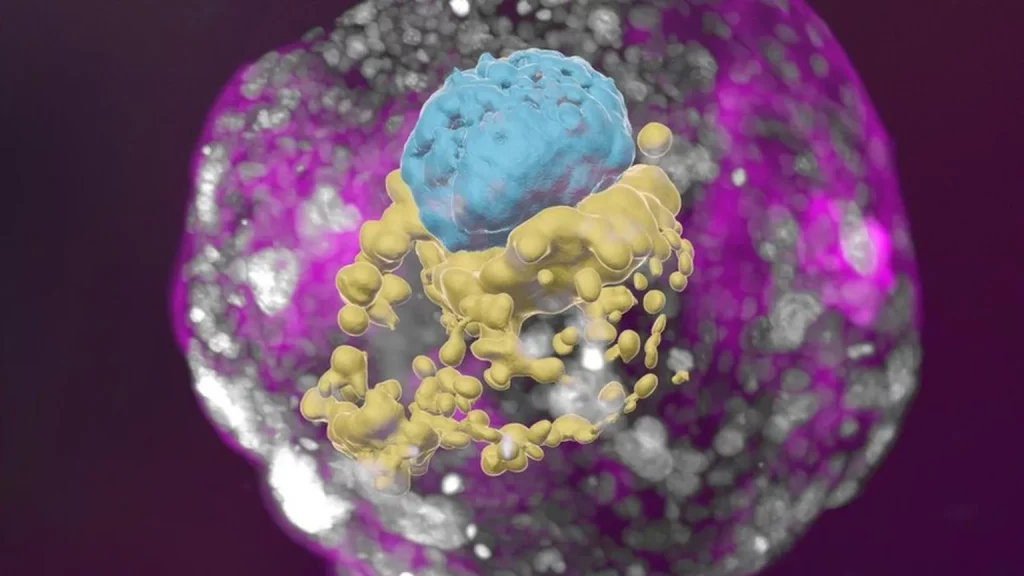
By: Caroline Cirella
Scientists at Israel’s Weizmann Institute have grown a model that closely resembles the early stages of a human embryo without using sperm, eggs, or a womb. [1]The rapid advancement of embryo models has allowed the models to become increasingly similar to natural embryo development in humans.
The scientists at the Weizmann Institute are hopeful that work with embryo models could lead to advancements in testing the effects of drugs on pregnancies, better understanding of miscarriages and genetic disease, and even growing transplant tissues and organs. [2] Stem cell-derived embryo models are “self-organized, three-dimensional structures” that mimic the developmental processes observed in early embryos.[3] These models allow scientists to study the earliest stages of development in embryos and gain insight into the medical and genetic needs of embryos.
The team of scientists shared that their “embryo model” resembled a fourteen-day-old human embryo; it even released hormones that turned a pregnancy test positive.[4] This model marks the furthest scientists have advanced in developing an embryo model and the most similar the model has been to an actual embryo.
The team took stem cells originating from adult human skills along with others cultured in a lab and subsequently altered the cells back into an earlier stage when cells can mature into various cell types.[5] Next, they manipulated these cells with chemicals to create four cells which created the foundation for something that would resemble an embryo. A total of 120 of these cells were mixed in a precise ratio, and about 1% of the cell mixture spontaneously formed itself into a structure similar to an embryo.[6] This structure developed until it reassembled an embryo fourteen days after fertilization.[7]
However, the scientists are careful to differentiate between an embryo and what they created, an embryo model. [8]
Currently, the legal cut-off for embryo model development is fourteen days in many countries. [9] After developing to resemble a fourteen-day-old embryo, the model has developed internal structures but has not yet created the foundations for body organs. [10] Rapidly developing technology may allow scientists to develop embryo models past the point of not yet creating the foundations for body organs, while simultaneously altering the models to resemble human embryos more and more closely.
Although embryo models remain legally distinct from embryos, as time goes on, the models’ ever-developing similarity to embryos raises ethical issues that call for heightened regulation in this field. In addition to the expectation that these models will become increasingly difficult to distinguish from human embryos, we also must consider regulations regarding the cut-off of the development of these models.
Moreover, scientists have not yet reported allowing or having the ability to develop these models to a stage where they develop more complex structures like the foundation for organs. As we approach the point of developing the technology to advance to this point, it is necessary to ensure that ethical principles are adhered to in the testing and use of these embryo models.
As models become increasingly difficult to distinguish from embryos and we approach the advent of technology that can allow them to be sustained into further stages of development, it is also important that clear guidelines that ensure informed consent are enacted for participants who provide their stem cells or other specimens to create these models. Finally, given the global impact of scientific research, creating a consistent framework for research involving embryo models would be most effective for advanced regulations in an international setting.
Citations:
- James Gallagher, Scientists grow whole model of human embryo, without sperm or egg, BBC News, https://www.bbc.com/news/health-66715669/ (last visited 09.10.23 10:00 PM EST).
- Id.
- The Science of Integrated Human Embryo Models, International Society for Stem Cell Research, https://www.isscr.org/upcoming-programs/embryo-models-webinar/ (last visited 09.13.23 8:00 AM EST).
- Supra. Note 1.
- Id.
- Id.
- Id.
- Id.
- Id.
- Rami Amichay and Ari Rabinovitch, Israeli scientists create model of human embryo without eggs or sperm, Reuters, https://www.reuters.com/science/israeli-scientists-create-model-human-embryo-without-eggs-or-sperm-2023-09-07/ (last visited 09.10.23 10:00 PM EST).
